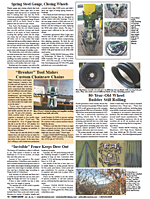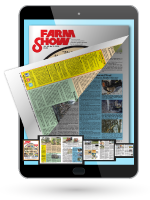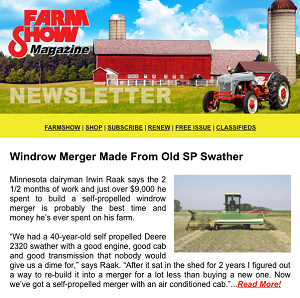You have reached your limit of 3 free stories. A story preview is shown instead.
To view more stories
(If your subscription is current,
click here to Login or Register.)
They’re Growing Peaches In Cold Climates
Dan Shield markets organic peaches and apricots in Minnesota. High tunnels provide an extended season, and black plastic silage tarp delays the bloom until the threat of frost is over. With these and other tools he developed, he’s produced as much as 120 lbs. of peaches from a single tree. Some peaches are 3/4 lb. in w
..........
You must sign in, subscribe or renew to see the page.

You must sign in, subscribe or renew to see the flip-book
They’re Growing Peaches In Cold Climates CROPS New Techniques Dan Shield markets organic peaches and apricots in Minnesota High tunnels provide an extended season and black plastic silage tarp delays the bloom until the threat of frost is over With these and other tools he developed he’s produced as much as 120 lbs of peaches from a single tree Some peaches are 3/4 lb in weight and 4 1/2 in across “I put up a 54 by 34-ft high tunnel in 2014 and planted 49 cherry trees and three peach trees ” recalls Shield “In 2017 the cherry trees produced hardly any fruit but the peaches produced 50 lbs each I tore out the cherries and planted more peaches and half the tunnel to apricots ” Since then he’s added a 72 by 34-ft high tunnel devoted entirely to peaches and is planning a third for more peaches and apricots The first tunnel was completed with a Sustainable Ag Research and Education SARE projects grant The second was through an NRCS EQUIP grant as will be the third The goal of the three grants is to identify the tools and knowledge needed for peach and nectarine production for local consumption One aspect is comparing peach varieties that thrive in Zones 4 and 5 to those that can survive and thrive with help in Shield’s zone 3 to 4 climate which can dip to -45 F Shield’s system overlaps the high tunnel clear plastic with a black/white silage tarp in the late fall He attaches it with wiggle wire and the plastic shrinks tight as temperatures cool The tarp serves multiple purposes It prevents heat spikes and double-seals the high tunnels against gaps or cracks that could let cold air in With its white side up the silage tarp reflects winter and early spring light until frost is no longer a concern Once the tarp is removed the trees rapidly flower Shield covers the ground under the fruit trees with black/white plastic also white side up The plastic ground cover holds moisture in the soil reducing humidity in the high tunnel and weed pressure Once the trees have leafed out the white plastic reflects light into the canopy It counters the 15 to 20 percent of light lost due to the clear plastic tunnel covering “I’ve actually developed a tan under my chin from the reflected light after spending only two days in the tunnels ” says Shield The ground cover tarp also reduces pest pressure as plum curculio is a major threat If an egg laid in the tree pupates and drops to the plastic as a larva it can’t drill into the earth to develop Breaking the pest life cycle is important to Shield’s organic production Extreme cold weather requires backup heat even with the silage tarp and the high tunnel plastic If the temperature falls into the danger zone a thermostat activates heat tape strung through the trees Kerosene heaters also serve as a backup Shield gives the trees in the high tunnel a 5 to 7 ft space versus putting them on 12-ft centers if planted outside He uses a rootstock that works in clay loam soils Combined with selected varieties the program has been more than successful “I have a waiting list for my peaches ” says Shield “People make an appointment to pick them up when ready and pay $4 per pound I have no problems selling out ” Shield estimates a 2 500-sq ft high tunnel of peaches can make $11 000 in a good year “I’m looking for cultivars that’ll bear throughout the season from the end of July through the end of September ” says Shield “People ask me why grow peaches in this climate People love them and we’re reducing the carbon footprint by what could be thousands of miles of transport We produce tasty peaches that are profitable for the farmer and don’t require fungicides and herbicides ” Contact: FARM SHOW Followup Stone Creek Farm 20382 310th St Shafer Minn 55074 ph 952-240-5066; grafted73@gmail com
To read the rest of this story, download this issue below or click
here to register with your account number.





